|
|
What is a Carbon-Footprint?
Wikipedia defines carbon-footprint as "the total set of GHG (greenhouse gas) emissions caused directly and indirectly by an individual, organization, event or product" (UK Carbon Trust 2008). On the web you can find carbon-footprint calculators along with suggestions how to lower your personal carbon-footprint. (For example, the Stop Global Warning Site ) In this document we are focusing on reducing the carbon-footprint due to printing.
Why Bother?
Paper is one source of greenhouse gas emissions (GHG), produced at each step of the manufacturing process, including the production and transportation of raw materials as well as the management of waste. The use of recycled paper helps substantially. One study of paper cited on PaperSpecs.com indicated that "on average, one metric ton of virgin paper in North America produces 4245.1 kg equivalent of CO2, while the same ton of 100 percent recycled paper produces 1791.1 kg."
Using recycled paper is a big help, but what we really need to do is go on a "paper-diet". The web is full of sites encouraging us to decrease our consumption of paper. Check out shrinkpaper.org for one.
Here are some vital statistics from greenprint.com that should motivate you to stop printing so much.
Ink is also a source of green-house emissions so along with using less paper, we want to use less ink.
WDRS and Paper and Ink
WDRS has already made considerable progress in trying to cut down on paper use. Some examples of these efforts are:
Nevertheless we still print and copy lots of documents.
Examine the pdf file or graphics file to see how paper usage has varied for the 15SE Workstation, the 3700 color and the black and white printers in the Education Office. We have crept up a little with the 15SE Workstation, are almost back to where we started with the color printer in used by people on 15W, but have continued to improve with the black and white printer in Education. If you use the color printer, try to think if there are ways that you can print less or maybe print multiple pages per sheet. Ask yourself if you really need to print? Do you really need a hardcopy for your records? Note: After the publication of these plots, we discovered that the Benefits Office has been using the color printer more than usual because their printer has been down.
Look at the pdf file to see how paper usage has varied for the 15SE Workstation, the 3700 color and the black and white printer in the Education Office. We started recording the 3700 and black and white paper statistics later so we have less data. Paper use has definitely declined at the end of the year.
As various departments make more efforts to cut down on paper and ink usage, we will add more content here:
The Employment Department began issuing electronic job offer letters (pdf files scanned using the two main printers on the east side of 15). This allows the candidate to instantly receive their offer letter. The candidate still receives a hard copy in the mail, but this is required for original signatures for the personnel file. We eliminated the need to Fed Ex offer letters which generated extra cost, envelopes, and processing thru the mail room.
Also, the new hire orientation "to join" process contains nearly all of the pertinent new hire paperwork online. Employees can review materials online and print out only the necessary documents on their own. The I-9 employment verification process is also now completed online, eliminating the need for paper copies.
To measure our success, we have been tracking the statistics on the color printer on 15W and the Workstation in 15SE and . This graph shows the average # of sheets per working day per person for the period previous to the bar.
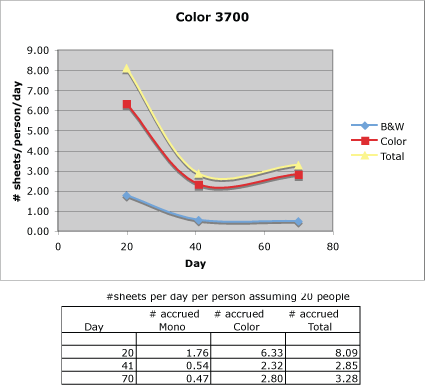
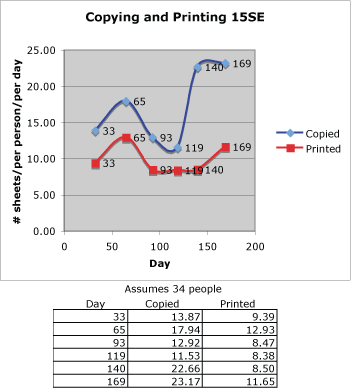
We've made a change in the Section office that I would like to share with you. There is a quarterly report that I run that prints 360 pages. Instead of printing everything and highlighting what was needed, we have asked to have the report run only the pertinent information. The report now is 170 pages. That's a savings of 190 sheets of paper! Thanks to Linda Christiansen and Laura Stover for making this possible.
Along with the quarterly report, additional pages of information are sent to D/S/C Heads. That information has been posted on the web and its URL address is given in the memo that is distributed with the report - saving more paper!
Here's the graph of paper use on the copier/printer on 15SE. We seemed to be making great progress and then the last twenty days indicate a huge increase in copying. This is an example of the seasonal fluctations and the VISA office's need to use the 15SE printer to provide one-sided printed materials for the U.S. Citizenship and Immigration Service. We can improve our processes, but not those of governmental agencies.
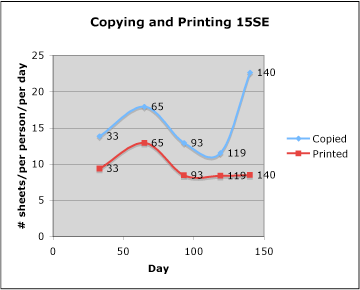
Laurie Pederson reports that she is converting many of her hardcopy documents to pdf files using the tip we sent out previously. She can send them to herself or to a list of recipients without having to make hardcopies.
Our paper usage continues to go down on the Workstation in 15SE. Let's keep it up.
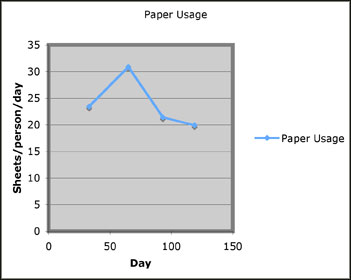
To measure our success, we have been tracking the statistics on the Workstation in 15SE. This graph shows the average # of sheets per working day per person for the period previous to the bar. The date range for the reading is in the bar. The usage varies according to the needs of our programs, but the latest reading showed some improvement! It might be easier to read if we took the data every 30 working days, but this is what we have so far.
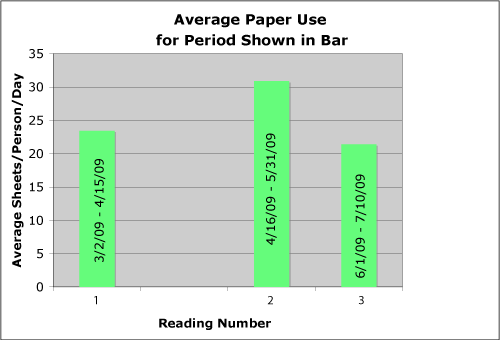
The Employment Department held a virtual job fair last week. We had about 800 visitors to our "booth" and about 60 chat sessions with applicants throughout the day. This eliminated the following:
I removed the cover page years ago. I don't know how to do it but had Desktop Support do it for me. WOW What a savings!
I re-use paper as drafts or scrap as long as there is no confidential information on it.
Other habits that I've gotten use to: "print preview" and adjust margins on documents for it to print all on one page, either in Word or Excel. Use the Set Print tool in Excel to print only the area you need rather than the entire spreadsheet. The Comp Group shreds as much as possible rather than throwing the paper away.
The Office for Professional and Organization Development initiated these steps:
Are Hardcopies Required?
Each time you print to hardcopy, ask yourself if you really need a paper copy of this document. Try to get used to reading documents on the web. Provide your colleagues with electronic documents instead of printed ones. If you are teaching a class, consider delivering the materials for the class online or on a CD or DVD.
If you have problems reading a document on the computer screen, make sure you have a good prescription for your eye glasses. Also remember that you can always pump up the size of the font.


Those of you who are used to reading from books and papers may find it difficult to make the transition to reading documents on a screen. At least give it a try. If you are proofreading a document, rather than marking up a printed page, maybe you should be making the changes directly to the document with tracking turned on as shown here for Microsoft Word. 

Markup actually gets the job done rather than taking a two-step process of marking up on paper and then putting the changes in the electronic document.
If You Have to Print

If you have to print, we provide techniques that might help cut down on the number of pages and the amount of ink you use.
We provide instructions for PC and Mac users and many of the printing examples are from Microsoft Word. They assume a particular printer setup, but they should serve to give an idea where to change settings on any printer.
Setting up Your Printer Correctly
When setting up your printer, you are better off selecting the printer driver associated with your printer rather than using the generic printer. Look for the company and model number when choosing the driver. This way you can take advantage of the special capabilities of your printer. The Computing Service Desk can help you if you need assistance.
Printing Duplex
Most printers support the ability to print duplex, on both sides. Already this can cut the number of pages you print up to one half!
If the printer you use most frequently does not support duplex printing, either find a printer that does or ask your system administrator whether they can purchase a duplex unit for the printer.
When you go to print, you should see a dialog box where the default is generally "1 sided print."


Already this can cut the number of pages you print in half! If the printer you use most frequently does not support duplex printing, either find a printer that does or ask your system administrator whether they can purchase a duplex unit for the printer.
Printing Multiple Pages per Sheet
This is particularly relevant when you are printing out handouts for meetings. To avoid this altogether, you might consider putting your talk on a server for people to download or access directly from their computers when they come to the meeting. It really depends on whether the people to whom you are talking bring a computer to talks and whether they need a hardcopy to make notes on. If your audience requires hardcopies, then print at least two per sheet and make them double-side.


Printing Preview
Sometimes all you really want to do is to see how your document looks - Print Preview. Often you want to see how a table or graph is lining up and you don't need to print to paper. You can do some of the early proofreading by looking at a preview. It may be that you really don't need to print your document to the printer until you have the final version. You can Print Preview from the File Menu. Be sure you choose the printer on which you plan to print the final copy if you need it to be a hardcopy. Different printers behave in a different manner.

Also available in some print dialog box is a Quick Preview
that allows you to click through the pages and see how each lays out on the
page. This may be sufficient when you are trying to get rid of white space.

Printing Only the Pages You Need
Often we only need one part of a document. Don't print the whole document! Just choose those pages and enter the page numbers:


Printing to PDF
Sometimes we don't really need to print the document to hardcopy, but we want an electronic version. It is an easy way to make an Operating-System-independent document that we can send to our colleagues or put on the web. It is useful also for web pages and email messages that we want to be able to look at later and may not remember the URL or may have deleted the original email. 

Print Cover Page (turned off)
Most of us have this turned off, but maybe you don't. In an office with lots of people, including a print cover page makes it easy to keep track of your work, but it eats up a lot of paper. Title your documents so it is obvious they are yours. If you are printing another person's document, this may not be so easy. If you are printing one-page documents, you are often doubling the paper consumption each time your print.


Saving commonly-used options
Once you have all your settings the way you want them, you save them to a "Default" ("Standard") or as one of the "Presets".


Formatting Your Document
You can set the margins, font size, etc. in your document to cover more of the page and be denser. You also can resize images so there are not big gaps in your document because your image won't fit on the remaining part of the page. In a document like this one with lots of screen grabs, it is hard to avoid too much white space where the picture you insert doesn't fit on the same page as the text and therefore is placed on the next page. In the case of this document, we are hoping that you will never print it out, but instead you will open it on your computer and use it from there.
Here are some recommendations from the web site Reach for Unbleached Foundation
"The good news is that you can easily tweak a few of the default settings in Microsoft Word to make your documents print more efficiently and use quite a bit less paper. While you might not want to do this for "formal" documents, making these tweaks can help you save a lot of paper when working with "draft" documents or documents that are purely for internal use. These tips were adapted from an article in Office Watch, one of our favourite sources of information on all things Microsoft Office.
Three simple Word formatting tweaks to help you save paper:
How do you do make these changes? While Word has lots of ways to change specific settings, if you want to make all of these changes at once, nothing beats working on the default template directly." 

Line spacing determines the amount of vertical space between lines of text. Microsoft Word uses single line spacing by default. The line spacing you select will affect all lines of text in the selected paragraph or the paragraph that contains the insertion point. You can set line spacing on the Indents and Spacing tab (Format menu, Paragraph command). The default of single line spacing is a big improvement over 1.5 lines and double spacing so you may not need to worry about this. On the Mac, it is a little confusing where to change this.
Using GreenPrint
There is a cute little application for Windows and Mac OSX Leopard that allows you to control the pages you print and whether you print graphics and/or text. It keeps a log of how much you have saved in paper and cost by eliminating printing blank pages and unwanted images. There is a free trial version to test and it may actually be enough to use the 30-day free copy to train you into better habits. There is a free version that does not have all the functionality of the $29 version, but it does provide the main benefits. Look at
Ask your system administrator if have problems installing it. It does require some overhead in the time it takes to analyze the print job and for you to delete pages or content. You may decide that you want to concentrate on other techniques to cut down on your printing.
Print to Draft
With some printers, you can change the Image Quality to save toner. This will make everyone happy because we won't run out of ink as quickly.


Eco Font
You can use a font that does not use as much ink as other fonts. This is accomplished by making tiny dots throughout the solid part of the character. The human eye does not notice them.

Read more on the Eco Font website.
Paperless Office
The applications on your computer provide lots of ways to keep important documents. There is lots of online help available to take advantage of this functionality. Here are a few ideas.
Managing E-mail
Save your e-mail into folders either manually or defining rules for storing them. Even if you do not save them into folders, most e-mail programs allow sorting by the sender, by topic, date, etc. and also searching in each of these categories. You should not have to print out important email because it remains in your e-mail system unless you set it to delete automatically. If an email is especailly important, you can also print it to a pdf file and store that in a folder where you can access it easily. By the way, one way to remind your correspondents that they might not want to print the mail you send them is to append a message to your signature. For example, Liz Quigg has this signature.
Liz Quigg
Fermilab
MS 226, Box 500
Batavia, IL 60510
630 840-2631
edreg@fnal.gov
"Save a tree; think twice about printing this e-mail."
Electronic Notes and Tasks
Mac operating systems have Stickies that allow you make all sorts of notes. You don't have to be scratching these on a piece of paper. You can even search through these. You can put them on your doc for easy access. Using Outlook 2007, you can set up electronic "tasks" to help you manage your "to do" list that contains reminders, priority levels, even allows you to assign a task to another person.
Electronic Calendars
Electronic calendars allow you to keep track of your life and send you emails or alarms to remind you of important meetings. They have more functionality than a little note book. You can keep a "to do" list with due dates along with your calendar items. If you have a PDA such as a iPod or iPhone, you can synch the information between the computer and device and have access to you calendar and contacts on both.
Scanning and Emailing Documents from Copiers
Many copiers allow you to scan a document and e-mail it to a list of people. For example, if you are given a hardcopy of a document you want to save for yourself or share with others, you can use the copier machine (WH15W_XEROX275) in the 15th Floor Southeast corner to email an electronic version of this document to yourself and others. You don't have to keep the original anymore. When you receive the email with the the resultant pdf file attached, you can save it to a folder on your computer. You can scan in as many pages as you want at a time just as you do when you copy documents. The full instructions for this are available on the web from the manual. It supports various quality of scans including those that can be used by OCR (Optical Character Recognition) programs to extract the text.
If you have a copier that indicates it supports this functionality, but you cannot get it to work, make out a servicedesk ticket and the Computing Division should be able to help you.
Windows: Zooming Text
In Microsoft Word, select Zoom under the View Menu and set the zoom value. Use the radio buttons or fill in a percent. Here the Zoom is set to 80%. Make it bigger.

In Internet Explorer and most browsers, you can change the font size:

MacOSX: Zooming Text
In Microsoft Word, select Zoom under the View Menu and set the zoom value. Use the radio buttons or fill in a percent. Here the Zoom is set to 125%.
|
|
|
In Safari and most browsers, you can change the font size:

Windows: Turning on Tracking in Microsoft Word
Click on the "Review" tab and then click on "Track Changes" in the center of the toolbars.
MacOSX: Turning on Tracking in Microsoft Word
Select "Track Changes - Highlight Changes" under the "Tools" menu.

It will bring up a dialog box where you should click all the checkboxes.

When you are editing, you might see something like:
![]()